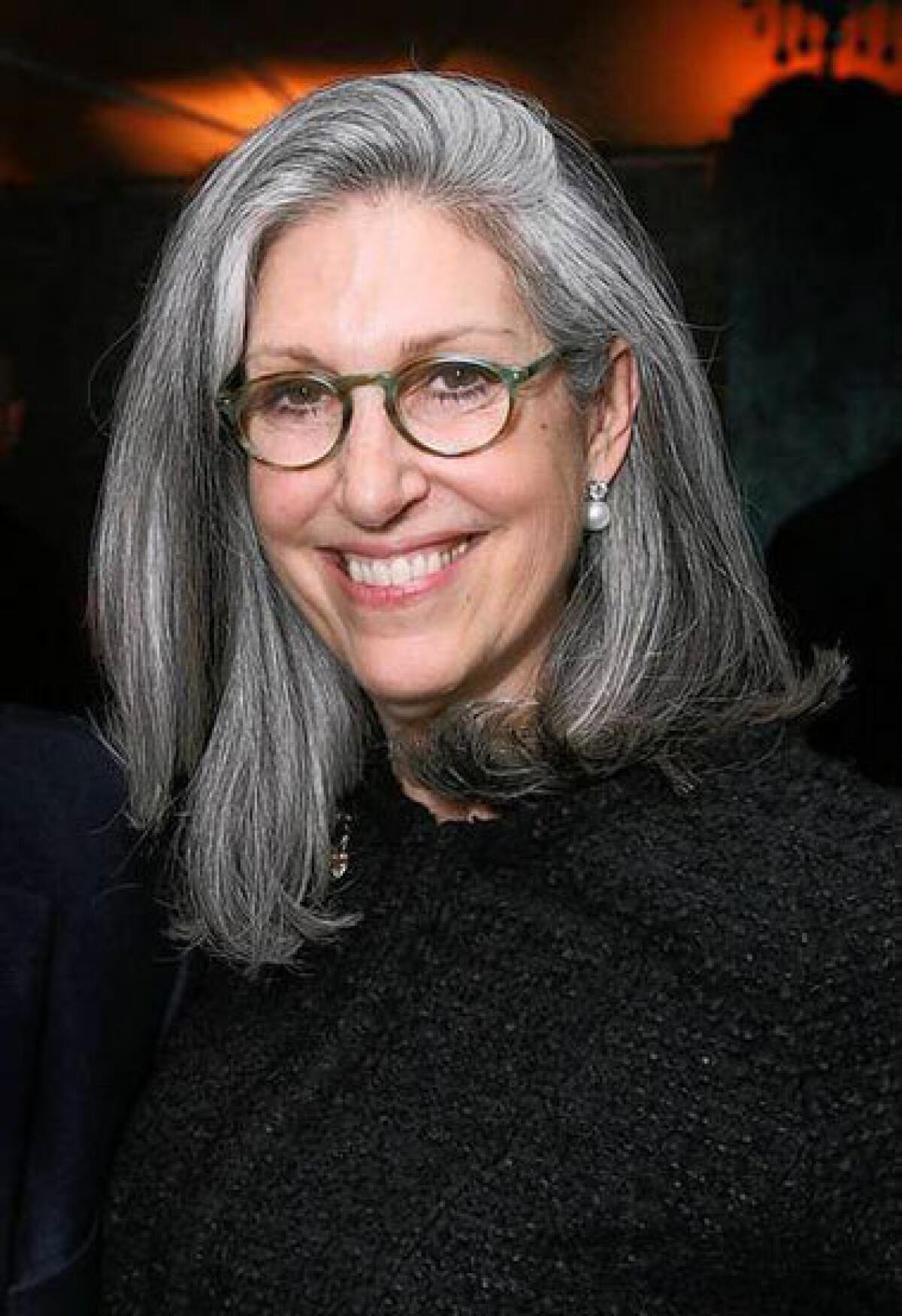Deborah Landis, ever the advocate for costume designers

Designing costumes so ingrained in popular culture that they still inspire Halloween disguises 30 years after they were created — Michael Jackson’s “Thriller” jacket, Indiana Jones’ signature outback slouch look and the unforgettable “College” sweatshirt from “Animal House” among them — would be enough of a career accomplishment for most people.
But not for Deborah Nadoolman Landis, who has spent the last decade fighting for respect, recognition and a place in the Hollywood pantheon for film costume designers, establishing herself as the flagbearer for the profession in the process.
Her career on screen includes collaborations with filmmaker and husband John Landis (they started dating in 1975 and married in 1980), beginning with the cult classic “Kentucky Fried Movie” (1977) and continuing with “Animal House” (1978), “Blues Brothers” (1980) and “Coming to America” (1988) — for which she was nominated for an Academy Award — as well as Jackson’s “Thriller” (1983) video and more. She also worked with director Steven Spielberg (“1941,” “Raiders of the Lost Ark”).
Off screen, she helped create the annual Costume Designers Guild Awards, and as a two-term president of the Costume Designers Guild, Local 892, which represents working costume designers in film, television and commercials, she campaigned for better pay and recognition for her colleagues.
“If you look at the hourly rate, costume design comes in right under craft services,” says Landis, 60, who lives in Benedict Canyon.
“Our job is often confused with diminutive stuff like shopping. But if you talk to costume designers, they want to have an intellectual discussion. They want to make great movies, not necessarily great costumes,” she says. “We design from the inside out, not the outside in. We bring characters to life.”
Along the way, Landis has written numerous books on costume design. And she is the David C. Copley Chair and the founding director of the David C. Copley Center for the Study of Costume Design at UCLA, after convincing billionaire and former San Diego Union-Tribune newspaper publisher Copley to donate $6 million to establish the center in 2009. In that role, she is creating an area of academic scholarship around the subject, educating students and the public about what it is costume designers do and don’t do.
“Her love of education and her dedication to her students is profound,” says Teri Schwartz, dean of the UCLA School of Theater, Film and Television.
Most recently, in what may be the pinnacle of her career so far, Landis curated the blockbuster “Hollywood Costume” exhibition, which is drawing record crowds at the Victoria & Albert Museum in London. The enterprise had her navigating the cloak-and-dagger world of costume collectors to reunite Dorothy’s gingham pinafore and ruby red slippers to display them together for the first time since “The Wizard of Oz” was completed in 1939.
The five-year winding yellow brick road she took to do that has provided many lessons. In any conversation of more than five minutes with Landis, the professor in her emerges.
LESSON NO. 1
Never take no for an answer
Since Hollywood studios have been notoriously bad at preserving history, securing costumes for the exhibition required a lot of detective work. When it came to obtaining one of four surviving pairs of the magical red shoes, all hope seemed lost. The Academy of Motion Picture Arts and Sciences declined. Landis met with private collectors too. One offered the left shoe but not the right.
But as Dorothy says, there is no place like home, and it was an old friend from L.A. who came through: John Gray, former president of the Autry National Center of the American West and current director of the Smithsonian National Museum of American History in Washington, D.C., agreed to lend the museum’s prized pair, one of the nation’s most popular attractions, but only for four weeks. The slippers had to be returned in time for Thanksgiving. (And they were.)
“She is so dogmatic and driven in her passion for costume design. It’s a never-ending thing,” says costume designer Jeffrey Kurland.
LESSON NO. 2
It’s about storytelling
That Landis, whose costumes must tell stories, is a good storyteller should come as no surprise.
The story behind how she obtained Dorothy’s pinafore was that a mysterious caller rang her office in London, instructing her to meet at the Temple street tube station, bring her ID and follow the uniformed guards to a private English bank. “Everyone was in cutaways, like in ‘Harry Potter,’ ” she says.
It was the first time Landis had laid eyes on the blue-and-white-checkered pinafore, which belongs to “Wizard of Oz” collector Heather Porter.
“I was worried I would look inside the pinafore and it would be fancy or lined with French silk,” Landis says. “But [MGM costume designer] Adrian was a genius. It was made on a treadle sewing machine, as Auntie Em would have done it, out of the cheapest Dust Bowl general store cotton. He didn’t mix fashion and costume. This pinafore is an exquisite artifact. And everything I put my heart and soul and intellect behind was validated when I saw it.”
LESSON NO. 3
Authenticity comes first
The treadle machine used to sew Dorothy’s pinafore was probably not all that different from the one that sits on a side table in Landis’ office on the leafy UCLA campus. An artifact of Landis’ own life, it’s the machine on which her grandmother taught her to sew.
Landis’ interest in costume design seemed preordained from an early age. She grew up in New York City, standing in the back of the house at Broadway shows and poring over history books about Elizabeth I, whose many representations on film are explored in a segment of the Victoria & Albert show.
She is the daughter of Milton and Laura Nadoolman, a pharmacist and a teacher of the deaf. And it was while making costumes as a kid for “bunk nights” at Camp Laughton in Grahamsville, N.Y., a camp for the deaf founded by her parents, that Landis learned the kind of versatility that would prove valuable in her career.
“I could make anything out of a paper place mat — a ruff, a cuff, a tie, a shirt collar and any kind of hat.”
LESSON NO. 4
Costume (not fashion) design
A self-described hippie who sat on her hair until she was 40 but now prefers a uniform of Armani and Lafayette 148 pants suits, Landis went to the freethinking Goddard College in Vermont. After failing to get a job at a costume house in New York City, she decided to go for her master of fine arts in costume design in Los Angeles.
She arrived at UCLA in 1973 and received a grant to study the influence of period detail on contemporary dress, an opportunity that gave her access to the inner sanctum of the fashion industry in New York City, including legendary editors Diana Vreeland, Carrie Donovan and Carmel Snow. The experience was fun but “made me realize I was interested in our field as material culture as opposed to a decorative art,” she says. “Every discussion led me deeper down instead of closer to the surface.”
LESSON NO. 5
Sometimes more is more
After graduating, she worked several years for Angie Jones, head of costume design at NBC Studios. It was a total education, Landis says. “Angie had me buying crystals, working on fat suits, assisting the cobbler. She made sure I saw everything.” The experience set her up perfectly to become a film costume designer.
After taking time off to raise her kids — Max, 27, is a screenwriter, and Rachel, 30, a teacher — Landis went back to school at the Royal College of Art in London at age 46, traveling back and forth for five years to complete her doctorate in the history of costume design in 2003. That led to a teaching career at USC, the AFI and eventually UCLA, thanks to David Copley.
Landis met Copley in 2006. The two bonded at his La Jolla mansion over his lifelong passion for collecting costume sketches, which Landis was researching for her newest title “Hollywood Sketchbook.” (Sketches were stashed everywhere in his house, including under the beds and in the backs of toilets, she says.)
Their friendship deepened when Landis was asked to be on the jury of the Cannes Film Festival in 2007 and invited Copley to sail his yacht to the South of France and accompany her to the festivities.
LESSON NO. 6
Tracking history never ends
Later that year, she approached Copley about endowing the first chair in costume design at UCLA’s School of Theater, Film and Television. “It was like I was discussing it with my father,” she says of her dear friend, who died, apparently of a heart attack, in November.
Now she is winding down her time in London. The exhibition, which features more than 100 costumes from 60 donors, is to run till Jan. 27 before traveling to Australia and, she hopes, Los Angeles. Next month she’ll be back to teaching, writing and hunting down costume history, whether she’s pursuing Edith Head sketches at the University of Wisconsin or Audrey Hepburn’s white Ascot dress, designed by Cecil Beaton for “My Fair Lady,” which sold at auction last year for $3.7 million and then disappeared.
As Landis tells it, “All this for these tired, old costumes. They are so much work, but they have so much intrigue.”
More to Read
Only good movies
Get the Indie Focus newsletter, Mark Olsen's weekly guide to the world of cinema.
You may occasionally receive promotional content from the Los Angeles Times.







